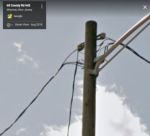Frank, I've worked in many houses with those two 30a fuses, mostly in Church Hill. Often, both the hot and neutral were fused, and I've also seen the fuses each supplying one floor. Yes, they used 30a fuses despite the 14g wiring. Being suspended and separated, knob-and-tube wiring was able to survive being overload better than NM.
When one of those houses is gutted, you can see the pair of upstairs floor-boards that were pried up to run the wiring from the front of the house to the back, the brace-and-bit-drilled holes for the ceramic tubes, and the knobs used where the wiring was fished vertically to the downstairs switches, and horizontally to the downstairs ceiling lights.

